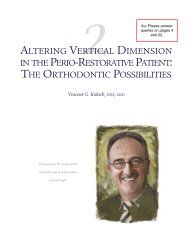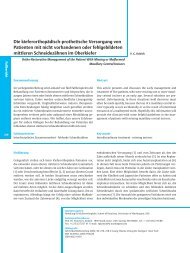Orthodontic and Nonorthodontic Root Resorption - Journal of Dental ...
Orthodontic and Nonorthodontic Root Resorption - Journal of Dental ...
Orthodontic and Nonorthodontic Root Resorption - Journal of Dental ...
You also want an ePaper? Increase the reach of your titles
YUMPU automatically turns print PDFs into web optimized ePapers that Google loves.
What is the incidence <strong>of</strong> moderate to severe<br />
root resorption after orthodontic treatment? Several<br />
radiographic assessments <strong>of</strong> consecutively<br />
treated populations <strong>of</strong> patients have been made to<br />
determine the prevalence <strong>of</strong> moderate to severe root<br />
resorption in both adolescent <strong>and</strong> adult populations<br />
<strong>of</strong> orthodontic patients. Moderate to severe root<br />
resorption is typically described as a greater than 20<br />
percent reduction in the original root length. Using<br />
this definition, the incidence <strong>of</strong> moderate to severe<br />
root resorption in an adolescent sample 2,5 is about 3<br />
percent. In adults, 18 researchers have shown that the<br />
incidence <strong>of</strong> moderate to severe root resorption is<br />
near 4 percent.<br />
Can root resorption be predicted? Previous<br />
studies have used statistical comparisons <strong>of</strong> gender,<br />
pre-treatment root form, pre-treatment root length,<br />
length <strong>of</strong> orthodontic treatment, premolar extraction,<br />
<strong>and</strong> linear amount <strong>of</strong> root movement as independent<br />
variables to determine if there are any accurate<br />
predictors <strong>of</strong> root resorption related to orthodontic<br />
treatment. In general, three <strong>of</strong> these variables show<br />
an association: amount <strong>of</strong> linear root movement,<br />
length <strong>of</strong> orthodontic treatment, <strong>and</strong> premolar extraction.<br />
5,6,19-22 If a patient were susceptible to significant<br />
root resorption, then the farther the tooth is moved<br />
<strong>and</strong> the longer the duration <strong>of</strong> the orthodontic treatment,<br />
the more root resorption would likely occur.<br />
In addition, epidemiological studies show that premolar<br />
extraction cases tend to demonstrate more root<br />
resorption in susceptible patients, probably because<br />
<strong>of</strong> the increased distance that the teeth move in extraction<br />
cases.<br />
Does the amount <strong>of</strong> force used during orthodontics<br />
affect the amount <strong>of</strong> root resorption? It<br />
seems logical that, in a susceptible sample, greater<br />
orthodontic forces would cause more root resorption.<br />
However, this assumption is not valid. Studies in both<br />
animals <strong>and</strong> humans have shown that the amount <strong>of</strong><br />
force placed on a tooth root has neither a positive nor<br />
negative effect on the amount <strong>of</strong> root resorption. 8,23<br />
On the other h<strong>and</strong>, studies in humans have shown<br />
that quadrupling the force on a tooth root does not<br />
produce greater root resorption, but can increase the<br />
speed <strong>of</strong> root movement through the bone. 9 Does it<br />
make a difference if the orthodontic force is continuous<br />
or intermittent? Researchers have clearly shown<br />
that although considerable variation typically exists,<br />
continuous forces tend to produce more extensive<br />
root resorption than intermittent forces. 13,14,24<br />
Is the tendency or susceptibility for root resorption<br />
an inherited trait? In the past, this question has<br />
been controversial. However, recent studies have<br />
suggested that external apical root resorption can<br />
be traced to a specific locus on a specific gene. 23,25<br />
These researchers believe that external apical root<br />
resorption is a complex condition influenced by<br />
many factors, with the IL-1B gene contributing an<br />
important predisposition to this common problem.<br />
Personally, I have treated two families <strong>of</strong> parent <strong>and</strong><br />
child, where both experienced moderate to severe root<br />
resorption during orthodontic treatment. It is evident<br />
that more studies evaluating a genetic determination<br />
<strong>of</strong> root resorption susceptibility are needed.<br />
Do specific types <strong>of</strong> orthodontic movement<br />
lead to greater root resorption in susceptible patients?<br />
Several authors have pointed out the negative impact<br />
<strong>of</strong> tooth intrusion on the severity <strong>of</strong> root resorption<br />
in orthodontic patients. 26,27 Perhaps this observation<br />
is due to the method <strong>of</strong> analyzing root resorption<br />
or root shortening on two-dimensional periapical<br />
radiographs. <strong>Resorption</strong> <strong>of</strong> the root apex after tooth<br />
intrusion can be seen easily on two-dimensional<br />
radiographs, whereas the root resorption seen on<br />
periapical radiographs after lateral root movement<br />
is not as clearly visible.<br />
What is the effect <strong>of</strong> root resorption on tooth<br />
vitality? Although no studies have analyzed this<br />
relationship, from a clinical perspective I have not<br />
encountered a tooth with moderate to severe root resorption<br />
whose pulp became nonvital. Unless there is<br />
some bacterial or traumatic insult to the tooth, pulp vitality<br />
does not seem to be related to the amount <strong>of</strong> root<br />
resorption experienced during orthodontic therapy.<br />
None <strong>of</strong> the pulps <strong>of</strong> the resorbed roots <strong>of</strong> the three<br />
patients illustrated in this article were nonvital.<br />
What happens over the long term to tooth roots<br />
that have undergone moderate to severe root resorption?<br />
Researchers have reevaluated patients with<br />
moderate to severe root resorption many years after<br />
orthodontics 28-30 <strong>and</strong> have found that root resorption<br />
stops after orthodontic treatment has been discontinued.<br />
Although there may be some remodeling <strong>of</strong> the<br />
irregular resorbed edges <strong>of</strong> the root with time due to<br />
reparative deposition <strong>of</strong> cellular cementum, this type<br />
<strong>of</strong> remodeling merely produces a smoother surface<br />
long term. However the length <strong>of</strong> the root does not<br />
continue to shorten after orthodontic appliances have<br />
been removed.<br />
Do teeth with moderate to severe root resorption<br />
require splinting? There are no studies that provide<br />
us with the answer to this important clinical question.<br />
In two <strong>of</strong> the cases presented in this article, the<br />
teeth were splinted either with a conventional bridge<br />
900 <strong>Journal</strong> <strong>of</strong> <strong>Dental</strong> Education ■ Volume 72, Number 8





